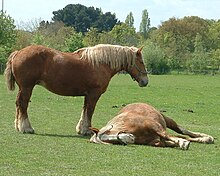Breton horse
| Country of origin | France |
|---|---|
| Standard | Association Nationale du Cheval de Trait Breton (in French) |
| Traits | |
| Weight | |
| Height |
|
The Trait Breton is a French
There are two principal subtypes: the Postier Breton is an agile harness and light draught breed; the Trait Breton is heavier, and best suited to agricultural work. The Breton was used as a
History
The Breton was originally bred for strength and durability.[4] One theory is that they were brought to Europe during the Aryan migration from Asia over 4,000 years ago, while another school of thought has them descending from horses bred by Celtic warriors before their conquest of Great Britain.[5]

The original ancestors of the Breton were a population of horses that lived in the Breton mountains, possibly descended from
A
The breed retained its mountain roots with its main stud, the National Provincial Stud, being located in the mountain country of
In France, breeding is concentrated mainly in the four Breton
The Breton has been exported to many countries, and has influenced a number of breeds. It may have influenced the
Characteristics
The Breton normally stands about 1.55 to 1.63 m (15.1 to 16.0
Registered animals may be
Subcategories
There are several subtypes of the Breton breed. Two, the Trait Breton and the Postier Breton, are officially recognised,[13] while others such as the Centre-montagne or Central Mountain Breton are not. Older types that have disappeared include the Grand Breton and the Bidet Breton or Bidet d'Allure.[7]

The Postier Breton was developed as a result of cross-breeding with the
The Trait Breton is derived from an infusion of

Uses
The Breton is used in many capacities owing to the various sub-types of the breed. Smaller types can be used under saddle and for fast, light draft work, whilst larger types are ideal for heavy draft and agricultural work. They are also commonly used to improve other breeds through crossbreeding. Today the breed is used as a draft horse on small farms and to gather seaweed. It is also bred for meat production;[5] horse meat is a dietary staple in many European countries, including France, Belgium, Germany and Switzerland.[16]
References
- ISBN 9789251057629. Archived 23 June 2020.
- ^ a b c Breed data sheet: Breton / France (Horse). Domestic Animal Diversity Information System of the Food and Agriculture Organization of the United Nations. Accessed September 2021.
- ^ ISBN 9781780647944.
- ^ a b c "Breton" Archived 26 August 2011 at the Wayback Machine The International Museum of the Horse. Referenced 1 August 2011.
- ^ a b "Breton". Oklahoma State University. Referenced 6 January 2008.
- ISBN 978-0-8061-3884-8.
- ^ ISBN 0-671-66068-3.
- ^ ISBN 0751301159.
- ^ Historique (in French). Association Nationale du Cheval de Trait Breton. Archived 27 July 2021.
- ^ Breton (in French). Institut Français du Cheval et de l’Équitation. Archived 14 February 2021.
- ^ ISBN 9781465451439.
- ^ "Studies from Complutense University update current data on animal science". Life Science Weekly: 337. 4 November 2008.
- ^ a b Le Trait Breton Syndicat des éleveurs du cheval Breton; Les Haras Nationaux (in French) Accessed August 2011
- ISBN 9780691167206.
- ^ a b c Règlement approuvé le 26 mai 2011: Règlement du stud-book du cheval Breton (in French). Annex to: Patrick Falcone (26 May 2011). Arrêté du 26 mai 2011 modifiant l'arrêté du 14 novembre 2002 modifié portant approbation du règlement du stud-book du cheval breton (in French). Journal Officiel de la République Française. 0129: text 32. ELI.
- ^ Johnson, Michael (19 June 2008). "Hungry for Horse Meat". New York Times. Retrieved 17 November 2009.
External links
- Site officiel du Syndicat des Éleveurs de Chevaux Bretons
- Le règlement français du Stud-Book de la race
- Le Trait Breton sur le site du Haras de Lamballe
